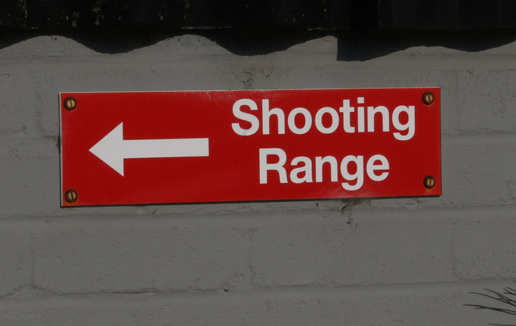 Providing access to all is one of the goals of the National Rifle Association’s Disabled Shooting Sports Program. There are many sportsmen and women throughout the country who have disabilities, and the NRA is currently hiring a Program Coordinator to help with implementing support programs that focus on hunting and on all disabled shooting activities.”
Providing access to all is one of the goals of the National Rifle Association’s Disabled Shooting Sports Program. There are many sportsmen and women throughout the country who have disabilities, and the NRA is currently hiring a Program Coordinator to help with implementing support programs that focus on hunting and on all disabled shooting activities.”
The ADA five-percent rule
The ADA requires at least five percent, and no fewer than one, of the assigned range shooting positions to have a turning space of 60 inches in diameter with slopes not steeper than 1:48 at the firing position.
Ranges where owners have not gotten around to improving their access need to make provisions for disabled shooters so that when disabled shooters come to use the facility, they do not face obstacles. For example, rural shooting ranges without running water providing portable toilets must provide ramps and have an entry wide enough for wheelchairs and without a ridge or step that would make it difficult to enter the toilet facility.
Other requirements are the same
Additional ADA accessibility compliance guidelines for outdoor shooting ranges are essentially the same as for other sports facilities. Where retrofitting is needed to comply with ADA access rules, the ADA requires range owners to bring their facilities up to standard in the following areas:
- Parking – Designate disabled parking spaces. Have well-graded or paved parking areas.
- Access paths – Ensure ample width with well-graded or paved turn-around or resting areas.
- Building entrances – Make sure building entrances meet ADA width and door access standards.
- Interior doors – Install proper handles. Doors need to be of proper width to allow wheelchair access.
- Public areas inside the facility – Make counter top heights, floor spaces, drinking fountains, etc., accessible and compliant.
- Bathrooms – Have door openings, toilet stalls, sinks and turn-around areas ready to accommodate customers with special needs.
- Grandfathering not allowed for sports
It is important to note that ADA does not exempt recreation facilities from the new access requirements of the 2010 Standards. The standards did not exist in the 1991 version and are not subject to “safe harbor.” So, on or after March 15, 2012, “public accommodations must remove architectural barriers … when it is readily achievable to do so.”
Join us: Become an Access Advocate
We are dedicated to leveling the playing field for people with disabilities. If you have experienced unreasonable barriers to enjoying full access to public facilities, contact us so we may advocate together!
Photo courtesy Flickr, Graeme Lawton
